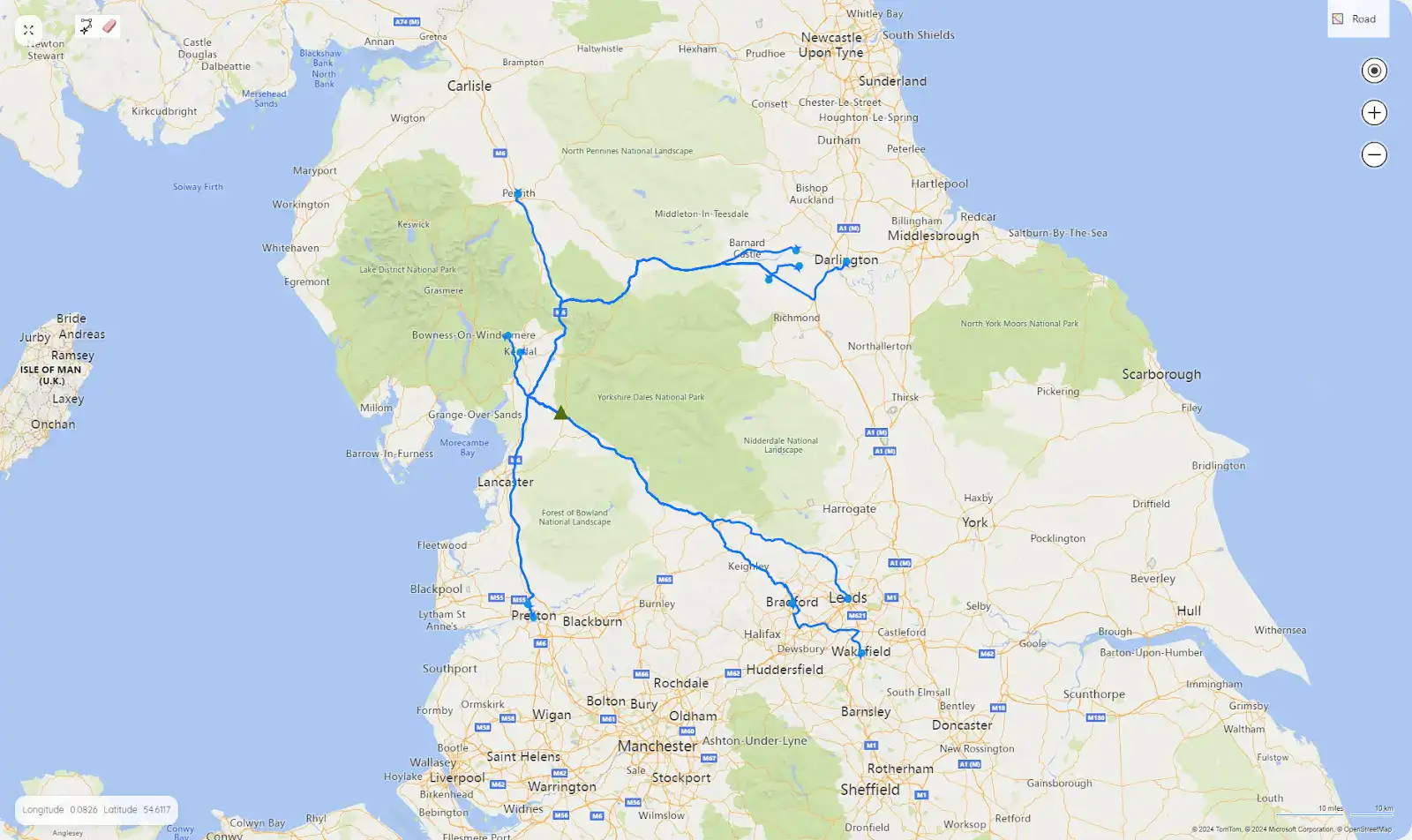Supply chain network design is crucial for meeting customer demands and minimizing costs. This involves strategically locating facilities like distribution centers to ensure timely deliveries and cost efficiency.
But traditional methods for determining these locations often rely on simple distance calculations, ignoring important factors like customer concentration and infrastructure availability. This is where greenfield analysis comes in. It’s a powerful tool that helps businesses address these challenges with clarity and precision.
Let’s explore greenfield analysis, its key aspects, and its transformative impact on supply chain network design and planning.
What is Greenfield Analysis?
Greenfield analysis is a strategic approach used in supply chain network design. It helps companies compare the number, location and size of distribution centers to meet customer demand effectively and efficiently

The term “greenfield” refers to the process of designing a new supply chain network from scratch, without the constraints of an existing infrastructure. This allows businesses to explore various scenarios and identify the most cost-effective and operationally efficient solution.
The key objectives of greenfield analysis include:
- Determining Facility Locations: Greenfield analysis evaluates potential distribution center locations based on factors such as proximity to customers, transportation costs, and infrastructure availability. This helps identify the sites that will best serve the target market.
- Transportation Infrastructure: The analysis considers the existing transportation network like road distance. This way businesses can identify locations that offer efficient and cost-effective transportation options.
Benefits of Greenfield Analysis
Implementing greenfield analysis in supply chain network design offers numerous benefits for businesses of all sizes and industries. Here are some of the key advantages:
- Reduced Costs: Greenfield analysis helps identify locations that minimize transportation costs which is a major expense in any supply chain. By strategically placing facilities closer to customer hubs and adopting efficient transportation routes, businesses can reduce overall logistics costs.
- Better Growth Opportunities: Greenfield analysis enables businesses to assess and validate expansion opportunities. This includes investments in new facilities or mergers and acquisitions to ensure strategic growth and market competitiveness.
- Enhanced Network Efficiency: A well-designed network minimizes inefficiencies and maximizes resource utilization. Greenfield analysis identifies the optimal number and placement of facilities, leading to a more streamlined and efficient supply chain network.
- Scalability and Future Growth: Greenfield analysis takes future growth projections into account. By selecting locations that can accommodate future expansion, businesses can build a network that scales alongside their needs, avoiding the need for costly redesigns later.
Optimizing Your Network: Greenfield vs. Brownfield Analysis
While greenfield analysis focuses on strategically placing new facilities within a supply chain, brownfield analysis tackles optimizing existing networks. Here’s a breakdown of both approaches:
| Feature | Greenfield Analysis | Brownfield Analysis |
| Focus | Designing a new supply chain network from scratch | Optimizing an existing supply chain network |
| Starting point | No existing facilities | Existing facilities |
| Ideal for | Businesses establishing a new network, expanding to new markets | Businesses looking to improve efficiency within their current network |
| Analysis options | Finding optimal locations for new facilities | Evaluating existing facilities for relocation or consolidation |
| Key Factors | – Proximity to customers- Transportation costs- Infrastructure availability- Demand patterns and forecasts | – Location of current facilities- Capacity and utilization of existing infrastructure- Opportunities for consolidation or expansion |
| Data Required | Customer locations and demand volumes | Existing facility locations, customer locations, and demand volumes |
Intelligent Greenfield Analysis with Sophus
Sophus X is designed to revolutionize greenfield analysis. The cloud-based solution enhances the accuracy and efficiency of supply chain network design. With advanced algorithms, Sophus provides deeper insights into optimal facility locations.

Traditional greenfield analysis tools can overlook a vital factor: complex geographic terrain. National parks and similar expansive areas that lack proper road connections and access to a labor force are unsuitable for a new distribution center or factory.
However, if the center of gravity is calculated using straight-line distances, such locations might be erroneously recommended by traditional tools.

Unlike traditional methods, Sophus goes beyond straight-line distance and uses road distance calculations. This is a game changer in areas with geographical complexities like waterways, deserts, or mountains, where straight-line distance is inaccurate.
Sophus offers a more realistic picture of travel times and transportation costs that align with the actual road network and potential traffic conditions. This ensures you avoid costly mistakes and make informed decisions based on real-world logistics.

Sophus offers two analysis types to cater to your specific needs:
- Site-Based Analysis: Find optimal locations based on a predetermined number of sites.
- Service-Based Analysis: Determine the optimal number of locations needed to meet specific service targets.
Sophus X key components and capabilities include:
- Straight-Line vs. Road Distance Analysis: The Sophus feature integrates both straight-line and road distance calculations. This ensures more realistic travel time estimates by considering actual road networks and traffic conditions.
- Advanced Optimization Algorithms: The tool uses sophisticated algorithms to analyze a wide range of variables. These include customer density, infrastructure availability, and regional regulations, providing a comprehensive analysis.
- Integration with Existing Data: Sophus features integrate with existing supply chain data. This allows businesses to utilize their current information for a more precise analysis.
Sophus also offers a number of benefits:
- Increased Accuracy and Efficiency: By incorporating a wide range of factors, the tool delivers highly accurate results. This leads to better decision-making and more efficient network design.
- Cost Savings and Resource Optimization: Optimizing facility locations can significantly reduce logistics costs. This includes transportation expenses and operational inefficiencies.
- Enhanced Decision-Making: The comprehensive analysis provided by Sophus AI’s feature supports informed decision-making. Businesses can confidently select the best locations for new facilities.
Steps To Run the Greenfield Analysis Using Sophus X
Here’s how Sophus can guide you through the process:
- Data Collection: Gather essential data points like customer locations, demand volumes, and any existing facility locations. Sophus can simplify this process by providing site coordinates based on postcode information or address.
- Input Data into Sophus: Log in to Sophus X to initiate the analysis process. Then import your compiled data using either the Excel import feature or the integrated ETL tool, Dastro, ensuring all relevant information is accurately integrated into the platform.
- Define Analysis Parameters: Specify the objective of your analysis such as the desired number of greenfield sites or service level constraints for these sites. Then choose your preferred distance calculation method such as a straight line or actual road distance. Select either Greenfield or Brownfield analysis depending on whether you’re considering entirely new facilities or optimizing existing ones.

- Define Scenarios: Sophus allows you to set up “what-if” scenarios. This lets you explore different possibilities, such as analyzing the impact of establishing one greenfield site versus two, or ensuring 30% of your customer volume is serviced within a 500-mile radius.
- Run the Analysis: Once everything is set, execute the analysis. Sophus will process your data and generate results.
- Review and Implement Results: Sophus provides outputs including maps and dashboards, to help you visualize the results. Review them to identify the optimal locations for your greenfield sites or the best configuration for your brownfield network. Finally, import the identified greenfield sites into the Sophus platform for further network design studies.
Unlock the Power of Intelligent Greenfield Analysis with Sophus X!
Are you looking to optimize your supply chain network for better efficiency and cost savings? Look no further than Sophus X, the leading supply chain design and planning platform.
Sophus X’s intelligent greenfield analysis feature goes beyond traditional methods, empowering you to make data-driven decisions that transform your supply chain. By seamlessly integrating advanced analytics, sophisticated modeling, and a deep understanding of logistics, Sophus Xi helps you determine the optimal number, location, and size of distribution centers to meet customer demand effectively and efficiently.
Here’s how Sophus X can help you:
- Streamline your greenfield analysis: Sophus’s tools automate complex calculations and data analysis, saving you time and resources.
- Make data-driven decisions: Sophus helps you translate data into actionable insights for optimal facility placement and network design.
- Build a future-proof supply chain: Sophus considers factors like growth projections and potential disruptions to ensure your network is adaptable and resilient.
Request a demo today and see how our intelligent greenfield analysis can transform your business.









